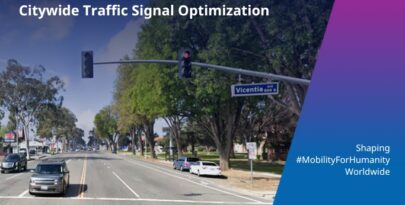CHALLENGE
Introduction
Well known for being the state capital of Wisconsin, Madison boasts a thriving recreational, cultural, arts, and community events atmosphere combined with affordable housing, nationally ranked schools, one of the best health care systems, and low unemployment. Madison has seen an annual growth rate of ~1 percent since 1970 – estimated 2014 population is 245,691. As traffic volumes rise with the population growth, it has put a lot of capacity pressure on the roadways in and around Madison, and planners do not see relief anytime soon. The projected population growth rate is expected to continue at 1.1 percent through 2030. Moreover, as the city home of the University of Wisconsin at Madison, traffic volumes fluctuate greatly for events throughout the year.
As a result, transportation management is an important focus for the City of Madison and the Wisconsin Department of Transportation (WisDOT). WisDOT and the City of Madison identified that the Verona Road (US 18/151) corridor – a major commuter corridor for the area – began to see unacceptable levels of crashes that were occurring more often than highways in other parts of Wisconsin. It was observed that the majority of collisions occurred at the intersections. Traffic had exceeded the roadway capacity. WisDOT and the neighboring cities decided to re-construct the highway to improve the efficiency and increase the capacity of Verona Rd.
Named the Verona Rd. (US 18/151) Project, the two-phased re-construction project, scheduled to be completed in 2019, will re-configure the highway more like a freeway, eliminating left turns and providing right lane(s) exits. However, to accommodate the construction, traffic would need to be bypassed onto the McKee Rd./Fish Hatchery Rd. (north to the Beltline Highway) corridor as an alternate route. City planners and engineers projected a 20 percent volume increase on the already high-volume, four-mile corridor as a result of the bypassed traffic.
EXECUTION
To proactively address the expected increase in traffic volume on the McKee Rd./Fish Hatchery Rd. corridor from Phase 1 of the project, the City and WisDOT turned to Centracs Adaptive. First, the City re-timed the 13 signals along the 4-mile corridor to increase the efficiency as much as possible until Centracs Adaptive was deployed. Helping the City of Madison and WisDOT with the complex re-construction project are the engineering/construction firm Strand Associates (Madison, WI), and traffic management consultant Traffic Control Corporation (TCC) (Woodbridge, IL).
The Econolite Centracs Adaptive system was deployed in July 2014. The City of Madison leveraged a combination of vehicle detection sensors, including inductive loops, as well as above-ground video and microwave radar detection sensors to feed the necessary traffic data to the Centracs Adaptive module. The radar and Autoscope Encore video detection systems were primarily used for stop bar detection, while inductive loops were used for advance detection. In a few installations, the Autoscope Encore video systems were also used for advance detection as intersection departure detection – detecting vehicles leaving an intersection, providing traffic volume data ahead of the next intersection. By using a combination of detection sensor types, Madison is able to effectively meet the vehicle detection input data requirements for the adaptive signal control system, as well as enhance detection performance at various intersection types, and during varying weather and daylight conditions.
RESULTS
Upon activation, City traffic engineers began to see immediate travel time and reduced number-of-stops improvements. This was an unexpected surprise, as it substantiated claims to the effectiveness of adaptive signal control for varying and unique applications. What was most surprising was the level of improvement. Before-and-after travel time reports indicated up to a 22 percent reduction in travel times and a 65 percent reduction in stops. This level of improvement is often associated with applications where adaptive signal control is deployed to corridors that have outdated signal timing, or that have never been timed.
Incident Response Performance
Another capability Centracs Adaptive provided that exceeded the City of Madison’s expectations is the system’s incident response performance. On October 21, 2014, Beltline Highway closed from 8 a.m. to 9:15 a.m. as part of the re-construction project. As a result, there was a significant traffic volume spike.
The main highway closure during the peak morning commute caused an approximate 40 percent increase to traffic volume onto the McKee/Fish Hatchery Rd. corridor. The sudden spike of traffic volume a few minutes before 8 a.m. for this corridor would have likely created gridlock-type conditions that might have taken hours to recover. At 8 a.m., Centracs Adaptive was able to immediately recognize the sudden increase in traffic volume and adapt the signal timing, bringing travel time back to nominal conditions for the corridor within 30 minutes.
Centracs Adaptive has proven to be highly effective at helping to reduce travel times and unnecessary stops for bypass traffic along the corridor during the re-construction/highway improvement project. Its performance has helped the City of Madison manage the unique traffic situation better than expected.



